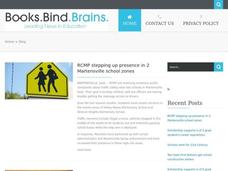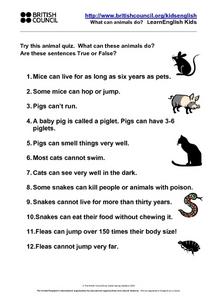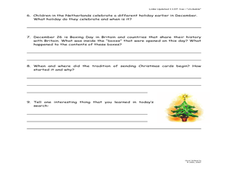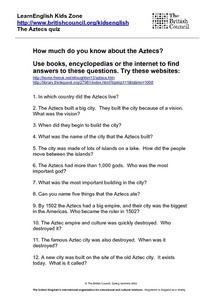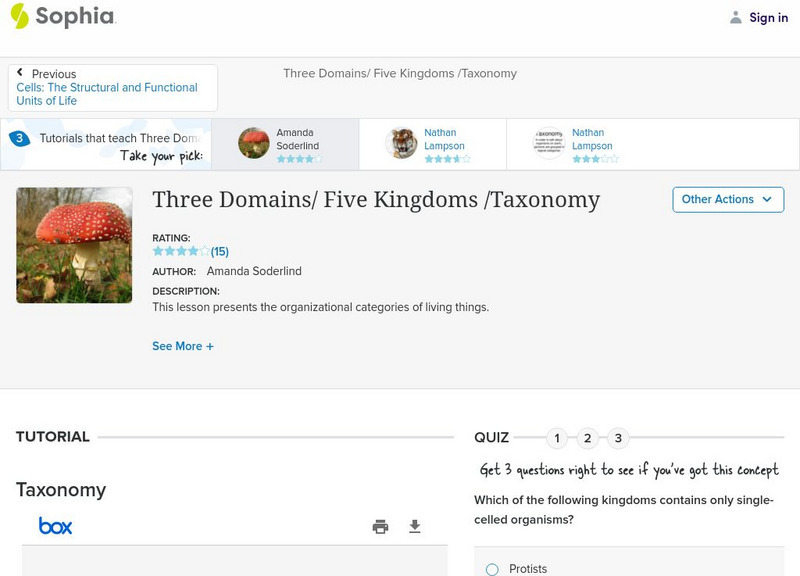Curated OER
The Chordates
Students study the characteristics of organisms that are a part of the phylum Chordata. In this organisms lesson students identify mammals that are native to Saskatchewan.
Curated OER
Shapes, Patterns, and Plants
Students imagine they are animals in the Palace Facade painting. In this Palace Facade lesson plan, students observe and discuss the geometric and organic shapes in the painting shown to them.
Curated OER
Diversity of Life
Pupils study the classification of viruses and describe their structure. In this investigative lesson students complete an activity and answer questions about viruses.
Curated OER
What Can Animals Do?
In this science related worksheet, students discuss and brainstorm what animals can and cannot do and then answer twelve true and false questions regarding the subject.
Curated OER
Learn English Kids
For this ESL Matching descriptions worksheet, students read 4 descriptions of different families and match them to the appropriate pictures.
Curated OER
Comparison of Political Ideologies in the Context of Constitutional Preambles
Pupils examine the various philosophies that form the foundations of political systems of major world countries.
Curated OER
Christmas Trees and Traditions
In this Christmas worksheet, students research the internet to find facts about Christmas trees and traditions. Students complete 9 short answer questions.
Curated OER
The Aztecs Quiz
In this social studies worksheet, students utilize books, encyclopedias and the internet to find the answers to twelve questions associated with the Aztecs.
BiologyWise
Biology Wise: The 5 Significant Kingdoms of Living Things
Describes the characteristics of the five kingdoms of living things - Monera, Protista, Fungi, Plantae, and Animalia.
Sophia Learning
Sophia: Three Domains/ Five Kingdoms /Taxonomy: Lesson 1
This lesson presents the organizational categories of living things. It is 1 of 3 in the series titled "Three Domains/ Five Kingdoms /Taxonomy."
Sophia Learning
Sophia: Three Domains/ Five Kingdoms /Taxonomy: Lesson 3
This lesson presents the organizational categories of living things. It is 3 of 3 in the series titled "Three Domains/ Five Kingdoms /Taxonomy."
Sophia Learning
Sophia: Three Domains/ Five Kingdoms /Taxonomy: Lesson 2
This lesson presents the organizational categories of living things. It is 2 of 3 in the series titled "Three Domains/ Five Kingdoms /Taxonomy."
ClassFlow
Class Flow: Animal Classification
[Free Registration/Login Required] This flipchart introduces the five kingdoms of animal classification. It includes Activote questions to assess understanding of the topic.
City University of New York
Classification: Bringing Order Out of Chaos
A self-directed module on all aspects of biological classifications that covers the species problem, diversity and chaos, cladistics, putting things in groups, and so on.
Other
Alternative Classifications of Life
The Linnaean system (1758) classified all macroscopic living organisms as either Animals or Plants, based on whether they moved [anima, with a soul] or not. Thus, Fungi were included as plants. With the invention of the microscope and...
ClassFlow
Class Flow: Binomial Nomenclature
[Free Registration/Login Required] This flipchart introduces the classification system and binomial nomenclature. It includes Activote assessment questions.




